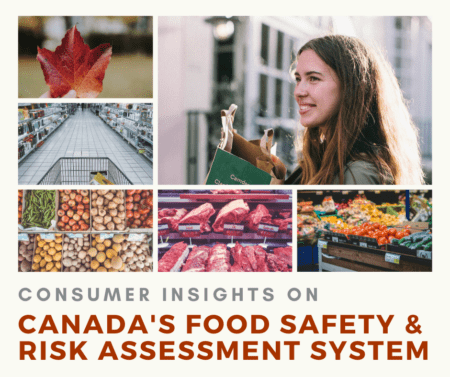Canada has one of the best food safety and risk assessment systems in the world. In the Conference Board of Canada’s 2014 food safety rankings, Canada placed first out of 17 comparable countries. Unsurprisingly, public opinion research conducted by Agriculture and Agri-Food Canada (AAFC) shows that Canadians have confidence in the safety of their food. Yet, while public trust in Canada’s food safety system is currently high, incidents such as the 2003 Bovine Spongiform Encephalopathy (BSE) crisis can rapidly affect this trust. Preserving positive relationships between consumers and members of the food safety system helps to ensure that future incidents are effectively managed and mitigated.
 Maintaining positive perceptions of Canada’s food safety system requires determining what areas of the system might be improved. In 2018, we surveyed 500 Canadians to evaluate consumer perceptions of the food safety and risk assessment system. We then used these results to determine what areas of the system are most concerning to the public.
Maintaining positive perceptions of Canada’s food safety system requires determining what areas of the system might be improved. In 2018, we surveyed 500 Canadians to evaluate consumer perceptions of the food safety and risk assessment system. We then used these results to determine what areas of the system are most concerning to the public.
Survey results reveal that, overall, Canadians trust the food safety system and the stakeholders involved. Public health services are the most trusted members of the supply chain, followed closely by farmers, provincial & territorial governments, and the federal government. Industry associations and agricultural companies are the least trusted organizations. When asked specifically about Health Canada and the Canadian Food Inspection Agency (CFIA), participants reported similar, positive perceptions of both organizations. However, approximately 25% of participants believe that Health Canada and the CFIA hide important information from the public and less than half believe that either organization does a good job of sharing information.
Participant trust in members of the food supply chain to ensure food safety 
Participants were also asked to comment on responsibility for food safety. When asked who should hold the most responsibility for food safety, the most popular ranking (from most responsibilities to least) was as follows:
- Government
- Food Manufacturers
- Farmers
- Retailers/Grocery Stores
- Restaurants
- Consumers
Expanding on this topic, participants were asked what level of risk each stage of food production poses to human health. Storage and handling by the retailer and processing and manufacturing of food products were perceived as bearing the most risk. Consumers’ relatively low-risk perception of at-home food preparation corresponds to the low consumer responsibility for food safety reported in the previous question. Additionally, 98% of participants ranked their at-home food safety practices as average or above-average. Considering that about 12% of Canadians will contract a food-borne illness every year, these results suggest our survey participants may be overconfident in their at-home food safety practices.
Perceptions of risk involved with each stage of the food production process
To determine general perceptions of the food safety system, participants were asked whether they agreed or disagreed with a number of statements. Just under three-quarters of participants agreed that compared to other countries, Canada has high food quality standards. Similarly, 65% trust the government food inspection system to ensure food safety and 62% are confident that their food is safe. However, 45% admitted to not fully understanding how food risk is managed.
Consumer confidence and knowledge in the food safety system
Finally, we asked what areas of the food system most concerned participants. Over 60% were equally concerned with how potential risks are tested and analyzed, how realized risks are managed, and how the public is informed of food risks and recalls. Yet, the single most commonly selected response was how the public is informed. Participants also commented on what they believe most influences consumer skepticism towards the food system. Limited access to accurate and reputable data received 46% of responses, followed by a lack of exposure to agricultural practices (35%), social media (34%), and use of technical jargon in information (32%).
The results generated by this survey shed a positive light on Canada’s food safety and risk assessment system. Yet, the trust exhibited by consumers should not be taken for granted as food safety incidents can establish rapidly and impact this trust-based relationship. The most commonly identified area of improvement was the communication of risks to the public. Increasing the accessibility of information for the public allows the relationship and trust between authorities, members of the food supply chain, and consumers to develop further.
Better communication might start with updating the CFIA’s existing Recalls and Safety Alerts notification system. Only 9% of our survey participants subscribed to these notifications, and of the 91% not subscribing, 95% were not even aware that this program existed. However, this notification system provides an excellent opportunity to enhance public communication of risk in an easily-accessible form. Expanding the social media presence of credible organizations such as Health Canada and the CFIA also provides the potential for reaching a broad consumer audience. Considering that the majority of Canadians surveyed by AAFC indicated the best communication method would be social media and that they would trust media shared by the government, making better use of these communication platforms is an excellent starting point for Canada’s food safety system.




